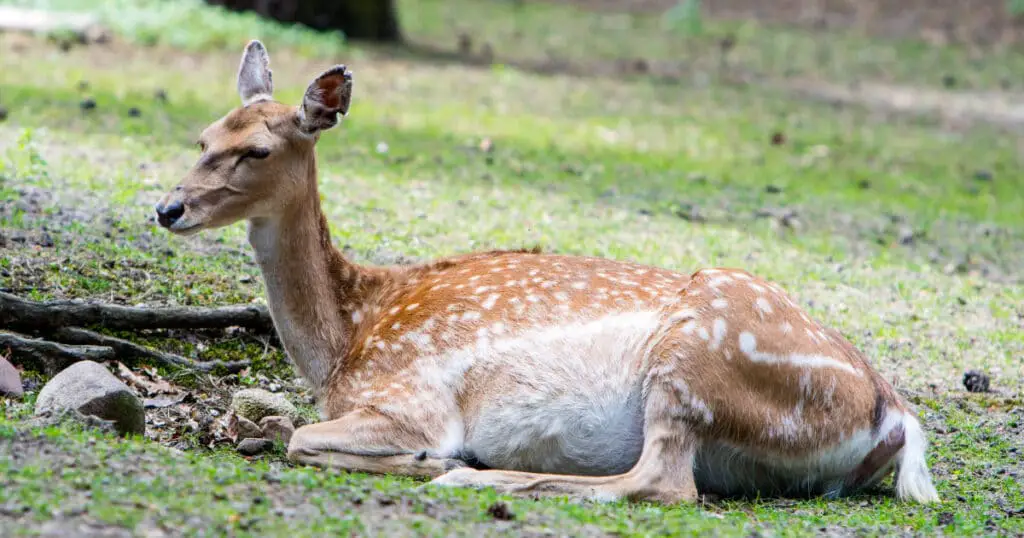The Persian Fallow Deer (Dama mesopotamica), is a very rare middle-eastern deer. Today this deer has ranges in Iran and Israel. Sometimes, this deer is called the Mesopotamian Fallow Deer. By most this deer is considered a subspecies of the European Fallow Deer. Others consider it to be its own unique species, closely related to its European cousin.
Debate About the Persian Fallow Deer
There is some disagreement about whether the Persian Fallow Deer is only a subspecies of the European Fallow Deer or whether it is different enough to be considered an individual deer species.
The main differences between the two types of Fallow Deer are its size (Mesopotamian Fallow Deer are larger) and the shape of its antlers.
What Does Dama Mesopotamica Look Like?
The Mesopotamian or Persian Fallow Deer is similar in appearance to the traditional European Fallow Deer. It possesses the same rich chestnut brown coat, which is speckled with white spots.

One of the most striking features of the Persian fallow deer is its considerable size difference between genders. Males are significantly larger than females; males can weigh between 90 to 100 kilograms, while females generally tip the scales at approximately 45 kilograms. Let’s break it down a bit further:
- Head: A male’s head may extend about 18 to 20 cm, excluding the antlers, which can reach up to 70 cm in length.
- Shoulder height: Standing tall at around 90 to 100 cm, these deer are quite distinguished in their stance.
- Antlers: Only males have antlers that they shed annually, with a unique V-shape and an impressive span.
- Tail: Their tails are relatively long for deer species, with a length of about 15 cm
However the Mesopotamian Fallow Deer is larger in size than its European relative, and has differently shaped antlers.
The antlers are not as flat or blade like as those seen in the European Fallow Deer and have more prominent frontal tines.
Where do Persian Fallow Deer Live?
The Persian Fallow deer has only a very small distribution range in western Iran and parts of Israel.
The habitat preferences of the Persian fallow deer mainly include open woodlands, grassy areas adjacent to forests, and marshy lands.
In ancient times they had a much larger distribution. A that time, these deer were found over much of southern Europe and northern Africa. However, they were hunted mercilessly. Today they have been wiped out over most of their historic range.
Reproduction Among Persian Fallow Deer
The breeding season of the Persian fallow deer occurs mainly in September and October. As part of their mating behavior, males engage in ritualized displays and combat to win over females. After a gestation period of about 230 days, females typically give birth to one, sometimes two, fawns.
Population Risk
Researchers found the last remaining pocket of animals in 1875 and they were named as a separate species. The wild population now numbers only a few hundred animals.
The Mesopotamian Fallow Deer is therefore at great risk of becoming extinct. It is listed as endangered by the I.U.C.N.
But there’s good news. This deer now benefits from protections in Iran, where their numbers are slowly increasing. A small number have been re-introduced to Israel where they are now breeding in the wild as well.
Preferred Habitat
Like the European Fallow Deer, the Mesopotamian Fallow Deer prefers areas of open woodland and forest.
Dama mesopotamica are similar to their European cousins in terms of how they behave and their mating rituals and reproductive behavior.
Frequently Asked Questions
What factors have contributed to the endangered status of the Persian fallow deer?
Habitat loss, poaching, and competition with livestock for food have been the primary factors leading to the endangered status of the Persian fallow deer.
Where can I see Persian fallow deer in their natural habitat?
You might be able to observe them in protected areas like the Dasht-e Naz Wildlife Refuge in Iran or the Carmel Hai-Bar Nature Reserve in Israel; just ensure any visit is done responsibly and ethically.
Is there any hunting allowed for the Persian fallow deer?
Due to their endangered status, hunting the Persian fallow deer is prohibited in most regions where they live. This species is protected under law to aid in its recovery.


